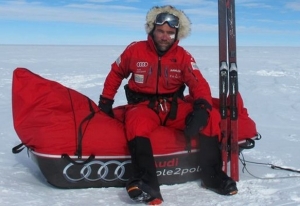Swedish Adventurer Addresses Packed Auditorium at the National Museum
Nearly 300 people crammed themselves into the auditorium of Tbilisi’s Simon Janashia National Museum of Georgia Wednesday evening, lined shoulder to shoulder against the walls, sitting on the wooden steps, and even overflowing out into the atrium, to see and hear a man named Johan Ernst Nilson. Now in his 40s, Mr. Nilson, a native of Stockholm, was brought here by the National Geographic Society of Georgia; over twenty years ago he embarked, on a dare, on a bike ride that would lead to him becoming an unlikely world explorer and the face of, and force behind, numerous international charities and environmental advocacy projects.
Looking worlds away from the battered explorer seen in his photographs, Mr. Nilson took the stage in a bright orange patterned scarf, clean-shaven and with a practiced, movie-star smile. His hour-and-a-half long talk led the audience along in his growth from a shy, nervous child who would hide behind the pommel horse to avoid getting picked for football to a practiced adventurer who has lived with cannibals and swum in the Arctic.
His theme for the evening, and the theme that he brings to his lectures around the world, was simple: Nothing is Impossible. “Failure”, he says, “is only delayed success.” His life became before our eyes both a drawn-out adventure story and a motivational speech. The most recent adventure, during which he traveled on his own power, on foot and by bike, from the north to the south pole, provided a centerpiece for the evening, but easily the most crowd-pleasing story came from earlier in his career, when he successfully piloted a makeshift aircraft, constructed apparently of a hang-glider and a rubber boat, from Stockholm to Gibraltar. Of all the images he showed, none more strikingly encapsulated his message that “Nothing is Impossible” (only difficult) than the sight of a grey rubber dinghy flying above a squadron of Danish fighter jets.
Mr. Nilson has become further well-known for his various charity endeavors, especially those related to climate change. He passed on his fears to the audience, while discussing his fight across the Arctic ice from the North Pole to Canada, that we may be the last generation to see the great ice shelf there at all.
Nevertheless, in conversation after the lecture, it wasn’t his environmental work that he focused on. “I feel most proud of the work I’m doing with kids,” he told Georgia Today. “The reason for that is that I see a difference. With climate change I don’t see a difference in time. With kids I hear mothers and fathers calling me up and saying that my kid, my child is actually making a change in school because of your lecture, because of your program. So they are choosing things that they didn’t dare before, that they are doing now. Those things I’m proud of.”
Robert Isaf












